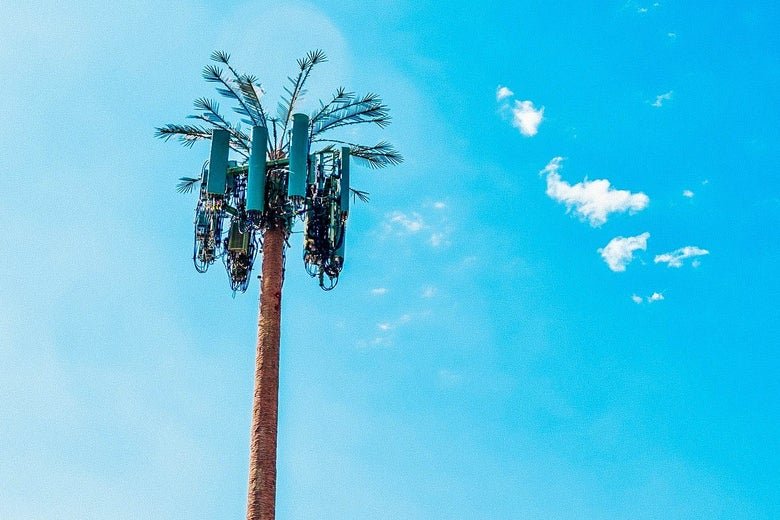The first step in improving the quality of your cellular signal in your home or business is to determine the nearest cell tower locations for your carrier.
The location of your nearest cell tower, and obstacles in between, can potentially cause signal issues where you’re at. Knowing where your nearest tower is can help you determine if there is an easy way to improve your signal, and if not, whether a cell phone signal booster system will work for you. We’ll walk you through how to determine your best cell tower location in this article.
Some Background About Cell Tower Locations
Here is some background information about cell towers and the sources that can be used to determine the locations of your carrier’s cell towers.
- Cell sites are required to register with the Federal Communications Commission (FCC) only if the antenna height is over 200 feet, or if they are within a designated flight path near an airport. Less than 50% of towers are registered as such.
- Cell sites are required to be registered if they fall under one of a few National Environmental Protection Act (NEPA) requirements.
- Mobile carriers do not willingly disclose their tower locations for safety and security reasons.
- A cell tower can have anywhere from 1-5 carriers providing service from it.
- A cell tower does not have to provide coverage in a full 360-degree circle.
- FCC Registered towers show only the owner and coordinates, not which carriers are using it to provide service.
- Towers can have from 1-7 different categories of cell service (e.g., 2G, 3G, and 4G) available from them.
- It is estimated by industry experts that 35-40% of all cell sites are not registered. This does not include any small cell sites, of which almost all are exempt from registration. A small cell is merely a compact, low-power version of a tower-based transmitter system. These are usually mounted on buildings or utility poles and serve a much smaller and specific area than a tower-based transmitter
There are a lot of different sources of cell tower data that can provide useful information on cell tower locations, however, each source has its own pros and cons.
Places to start your search:
The FCC Website
The FCC website has a significant amount of information and can be very useful if you are familiar with the industry, but much of the data is very raw, so it requires some work to find the information you’re looking for. This data source is going to be most beneficial for people familiar with the industry.
Carrier Maps (Links Below)
Each cellular carrier has its own maps displaying where they provide coverage. Two things to keep in mind when looking at carrier maps; they show coverage only, not tower locations, and each carrier typically has multiple maps for different uses, such as marketing, sales, and engineering.
Websites for Locating Cell Towers
Cell Reception
This website uses data from the FCC database, third-party information, Public Safety records, and FCC Radio Broadcast licenses to best determine where cell towers are located. It is better than most that rely on registrations only or crowdsourcing. This site will also give you an end-user sampling of reception and coverage.
Antenna Search
This website also uses data from the FCC database, third-party information, Public Safety records, and FCC radio Broadcast licenses to determine cell tower locations. This site does not have as much cell tower information as Cell Reception, which would indicate its records are less complete, and its updates less frequent.
Root Metrics
This site will not give you tower locations, but it is the best site for researching accurate, unbiased and scientific results for reception, coverage, and cellphone performance. Root metrics will give you the carrier ratings for upload and download speeds, text connectivity, call connectivity, and overall network reliability. All tests and results are third-party independent and uniformly tested, for all carriers.
Mobile Apps for Locating Cell Towers and Testing Reception
There are multiple mobile apps that claim to locate cell towers, however, by and large almost all are to some degree inaccurate, as they are dependent on the timely and complete updating of all new tower locations as they come online from the FCC. Additionally, there is an element of error using real-time triangulation and crowdsourced data gathering, so the results may not be completely correct.
Some of the paid apps are more accurate, but they require the insertion of cell tower base station information by a professional.
Open Signal
This app and website use crowdsourced data and FCC tower locations as its means of identifying cell tower locations. It was originally built for the Connect America Act of the US Federal Government. Subsequently, it was taken over as a private enterprise and is now trying to establish itself as an authority on grading the service of each carrier rather than as a tower location app.
The information provided may not be completely accurate, as much of the coverage data is gathered through the app while it is in use. The tower location information is a combination of data from the FCC database and user-generated triangulation data gathered while the app is active. This app can provide you with a good starting point for determining your nearest cell tower location, but we would still recommend using the manual verification process outlined later to confirm the tower location.
The diagram below illustrates how triangulation works, by using multiple cell phone locations to determine the cell tower location. The problem with this is that the approximate orientation of the towers could be off by as much as 90 degrees and thus show your tower in the wrong location.

